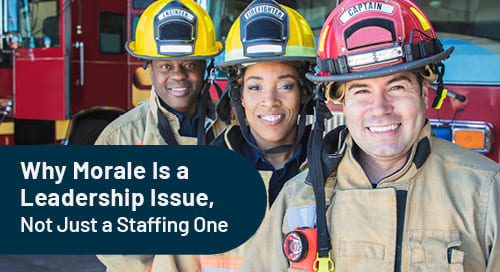 Across firehouses, EMS units, and police departments, morale is taking a hit. People are tired, stressed, and stretched thin. The go-to explanation? Staffing. And sure, having too few people on shift is a real problem, but it’s not the whole story.
Across firehouses, EMS units, and police departments, morale is taking a hit. People are tired, stressed, and stretched thin. The go-to explanation? Staffing. And sure, having too few people on shift is a real problem, but it’s not the whole story.
If we’re serious about improving morale, we have to stop treating it like just a numbers game. This isn’t only about staffing, managing, and supervising—it’s about leading.
The Cost of Low Morale
When morale drops, everything gets harder. Teams pull back. Communication breaks down. Turnover climbs, and the people who stay start feeling disconnected and discouraged. That’s not just a culture problem, it’s an operational risk. In first responder organizations, that risk can turn into real consequences for safety, performance, and public trust.
It’s Not Just About the Crisis
In high-stakes moments, command-and-control leadership works. It’s necessary. But those aren’t the only moments that matter.
Between the calls, the paperwork, the day-to-day interactions, those are the moments where morale is either built or broken. And that’s where leadership needs to show up differently. The routine can wear on people. In fact, repetition and predictability can lead to what some call “regression,” where team members disengage, become bored, or even complacent. In law enforcement, they often say, “nothing is routine,” and yet, familiarity can still breed a dangerous kind of contempt if not carefully led.
The reality is, many leaders haven’t been trained for those quieter moments. They’ve been taught to manage emergencies, but not to build trust, have tough conversations, or keep their teams connected through the grind. That’s where the real leadership challenge lives.
So What Can Leaders Do?
Raising morale doesn’t start with flashy perks. It starts with how you lead—every day. Here are three things leaders can start doing right now:
- Make time to listen. Not just in check-ins or debriefs. Create space where people feel safe sharing what’s really going on.
- Lead with flexibility. Different situations, and different people, require different leadership styles. Learn to adjust.
- Support growth. When people see that their leaders are invested in their development, it changes how they think, feel, and perform.
Blanchard’s Leadership for First Responders Course was designed with this in mind. We built it alongside first responder leaders who were tired of leadership training that didn’t speak to their reality. This course gives leaders practical tools to lead better—especially in those moments when things aren’t on fire (literally or figuratively).
Want to Know How You're Doing?
If you’re wondering how your leadership style stacks up, or where you might want to grow, take our Leadership Readiness Quiz for First Responders. It’s short, it’s insightful, and it might just be the first step to stronger morale across your team.
Because at the end of the day, leadership sets the tone. And morale follows your lead.
























